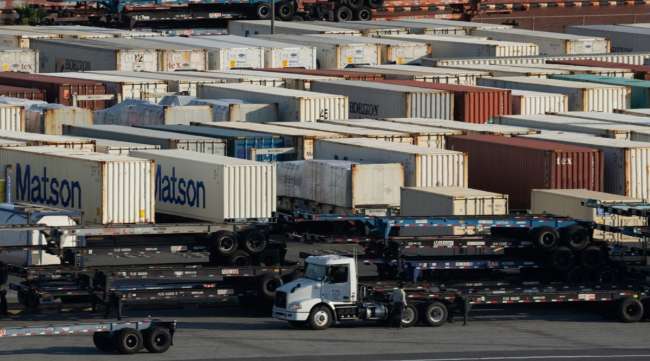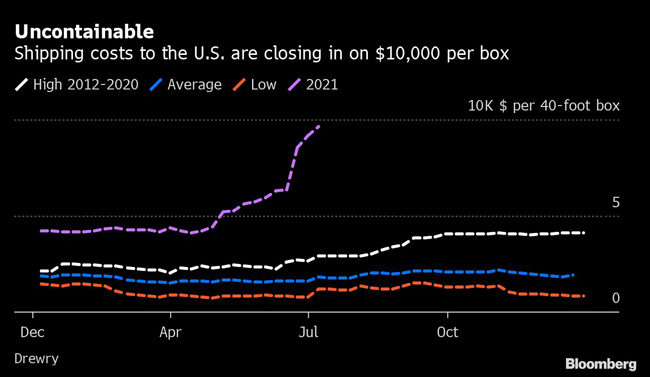229% Surge in China-US Shipping Costs Drives Inflation Pressure

[Ensure you have all the info you need in these unprecedented times. Subscribe now.]
The cost to ship a boxload of goods to the U.S. from China edged close to $10,000 as the world’s biggest economy keeps vacuuming up imports amid slower recoveries from the pandemic from Europe to Asia.
The spot rate for a 40-foot container from Shanghai to Los Angeles increased to $9,631, up 5% from the previous week and 229% higher than a year ago, according to the Drewry World Container Index published July 8. A composite index, reflecting eight major trade routes, rose to $8,796, a 333% surge from a year ago. Drewry said it expects rates to increase further in the coming week.
While the surging rates represent a profit bonanza for container lines including Copenhagen-based A.P. Moller-Maersk A/S and China’s Cosco Shipping Holdings Co., they’re making it more difficult for importers to absorb higher costs. Some are raising retail prices, adding to inflationary pressures that worry central banks, while COVID-related supply bottlenecks are also holding back economic activity.
The cost for a container from Shanghai to Rotterdam passed the $10,000 threshold in late May and has continued to rise. It reached $12,795 this week, according to Drewry. That’s up nearly 600% from a year ago.

Unthinkable Rates
The prospect of $10,000-a-box charges for the busy Asia-to-U.S. route would have been unthinkable to most shipping analysts before the pandemic. The average rate for shipping from Shanghai to Los Angeles was less than $1,800 per container from 2011 to March 2020, Drewry data show.
While demand from American consumers and companies is one reason for the rate spike, a shortage of containers remains another reason for the tight market.
Container capacity is particularly scarce for eastbound transpacific shipments, with COVID outbreaks at a port in southern China recently snarling both exports and imports. Meanwhile, a queue of vessels waiting to enter the twin ports of Los Angeles and Long Beach, Calif. — the largest U.S. gateway for oceangoing trade — showed little signs of going away.
The number of container ships anchored in San Pedro Bay totaled 18 as of late July 6, nearly double the queue of two weeks earlier, according to officials who monitor harbor traffic. That bottleneck has persisted since late last year, peaking around 40 vessels in early February.
The average wait for berth space was 5.3 days, compared with 4.6 in early June, according to the L.A. port. That number peaked around 8 days in April.
Want more news? Listen to today's daily briefing below or go here for more info:




